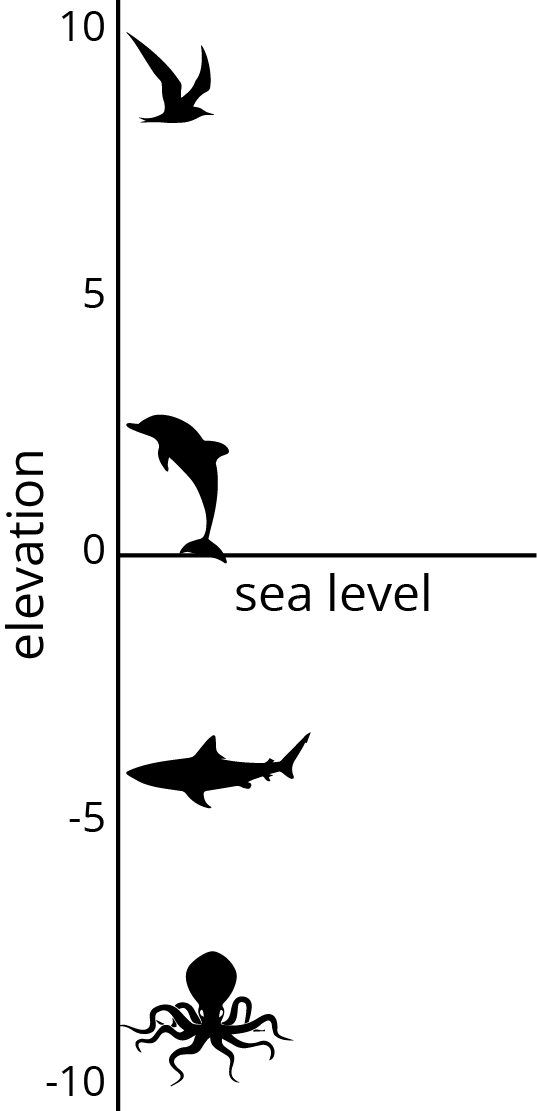1.1: Notice and Wonder: Memphis and Bangor

Let’s explore how we represent temperatures and elevations.

The thermometer showed a temperature of 7 degrees Celsius one morning. Later, the temperature increased 4 degrees.
We can represent this change in temperature using a number line, as shown here.

Here are three situations involving changes in temperature. Represent each change on the applet, and draw it on a number line. Then, answer the question.
At noon, the temperature was 5 degrees Celsius. By late afternoon, it has risen 6 degrees Celsius. What was the temperature late in the afternoon?
The temperature was 8 degrees Celsius at midnight. By dawn, it has dropped 12 degrees Celsius. What was the temperature at dawn?
Water freezes at 0 degrees Celsius, but the freezing temperature can be lowered by adding salt to the water. A student discovered that adding half a cup of salt to a gallon of water lowers its freezing temperature by 7 degrees Celsius. What is the freezing temperature of the gallon of salt water?
Here is a table that shows elevations of various cities.
| city | elevation (feet) | |
|---|---|---|
| row 1 | Harrisburg, PA | 320 |
| row 2 | Bethell, IN | 1,211 |
| row 3 | Denver, CO | 5,280 |
| row 4 | Coachella, CA | -22 |
| row 5 | Death Valley, CA | -282 |
| row 6 | New York City, NY | 33 |
| row 7 | Miami, FL | 0 |
A city has a higher elevation than Coachella, CA. Select all numbers that could represent the city’s elevation. Be prepared to explain your reasoning.
-11 feet
-35 feet
4 feet
-8 feet
0 feet
Here are two tables that show the elevations of highest points on land and lowest points in the ocean. Distances are measured from sea level. Drag the points marking the mountains and trenches to the vertical number line and answer the questions.
| point | mountain | continent | elevation (meters) | |
|---|---|---|---|---|
| row 1 | C | Everest | Asia | 8,848 |
| row 2 | H | Kilimanjaro | Africa | 5,895 |
| row 3 | E | Denali | North America | 6,168 |
| row 4 | A | Pikchu Pikchu | South America | 5,664 |
| point | trench | ocean | elevation (meters) | |
|---|---|---|---|---|
| row 1 | F | Mariana Trench | Pacific | -11,033 |
| row 2 | B | Puerto Rico Trench | Atlantic | -8,600 |
| row 3 | D | Tonga Trench | Pacific | -10,882 |
| row 4 | G | Sunda Trench | Indian | -7,725 |
A spider spins a web in the following way:
Assuming that the pattern continues, what will the spider’s elevation be after an hour has passed?
Positive numbers are numbers that are greater than 0. Negative numbers are numbers that are less than zero. The meaning of a negative number in a context depends on the meaning of zero in that context.
For example, if we measure temperatures in degrees Celsius, then 0 degrees Celsius corresponds to the temperature at which water freezes.
In this context, positive temperatures are warmer than the freezing point and negative temperatures are colder than the freezing point. A temperature of -6 degrees Celsius means that it is 6 degrees away from 0 and it is less than 0. This thermometer shows a temperature of -6 degrees Celsius.
If the temperature rises a few degrees and gets very close to 0 degrees without reaching it, the temperature is still a negative number.

Another example is elevation, which is a distance above or below sea level. An elevation of 0 refers to the sea level. Positive elevations are higher than sea level, and negative elevations are lower than sea level.

A negative number is any number that is less than zero. On a number line, negative numbers are always on the opposite side of 0 as 1. If a number line is drawn horizontally, the negative numbers are usually to the left of zero.

If a number line is drawn vertically, then the negative numbers are usually below zero, like most thermometers or on the vertical axis in the coordinate plane.
A positive number is any number that is greater than zero. On a number line, positive numbers are always on the same side of 0 as 1. If a number line is drawn horizontally, the positive numbers are usually to the right of zero.

If a number line is drawn vertically, then the positive numbers are usually above zero, like most thermometers or on the vertical axis in the coordinate plane.